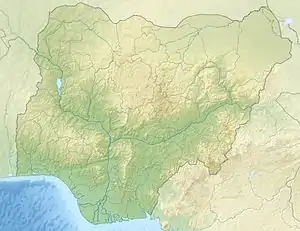Kainji National Park
Kainji National Park is a national park in Niger State and Kwara State, Nigeria. Established in 1978, it covers an area of about 5,341 km2 (2,062 sq mi). The park includes three distinct sectors: a part of the Kainji Lake in which fishing is restricted, the Borgu Game Reserve to the west of the lake, and the Zugurma Game Reserve to the southeast.[1]
| Kainji National Park | |
|---|---|
IUCN category II (national park) | |
_Kainji_Lake_National_Park_(4893517813).jpg.webp) | |
 | |
| Location | Niger State and Kwara State, |
| Coordinates | 10°22′06″N 4°33′17″E |
| Area | 5,340.82 km2 (2,062.10 sq mi) |
| Established | 1978 |
History
Kainji National Park was established in 1978 and is divided into three distinct sectors, the Zugurma Game Reserve, the Borgu Game Reserve and Kainji Lake.[2] Since 2005, the protected area is considered a Lion Conservation Unit together with Yankari National Park.[3] The park is owned by the state and managed by the Federal National Park Service (FNPS), receiving direct government funding. This means that enforcement actions against poachers can be pursued under national park law and not in the local courts.[4]
Geography
The Borgu Game Reserve is mostly made up of savanna forest and has an area of 3,929 km2 (1,517 sq mi), while the Zugurma Game Reserve is smaller, at 1,370 km2 (529 sq mi). The two main parts of the park are separated by the Kainji Lake, a 136 km (85 mi) long reservoir. The Zugurma sector has no access roads and only the Borgu sector is used for tourism.[5]
The southern and western parts of the Borgu Game Reserve drain into the Oli River, a tributary of the Niger River, while the other parts drain directly into the lake via four small rivers. The Zugurma Game Reserve has little drainage; the smaller watercourses dry up during the dry season, but there are a number of permanent waterholes along the Oli River and elsewhere in the park. The Borgu sector consists of undulating hills with some quartzite ridges and ironstone pans, while the Zugurma sector consists of a low plateau, with soils derived from sandstone, much eroded in places. The mean annual rainfall is about 1,100 mm (43 in), with the wet season lasting from May to November and the dry season from December to April.[1]
Flora
The savanna woodland of the Borgu sector is dominated by Burkea africana, Terminalia avicennioides and Detarium microcarpum. Below the quartzite ridges Isoberlinia tomentosa predominates, and further down the hillsides on the relatively dry lower slopes are stands of Diospyros mespiliformis, with an understory of Polysphaeria orbuscula. Terminalia macroptera occurs on moist savannas and Isoberlinia doka is found on higher ground in ironstone areas. In the Zugurma sector the tree cover is typical of the Guinean forest-savanna mosaic although this area is overgrazed and eroded, and the main woodland is besides the watercourses and waterholes. Common trees here include Afzelia africana, Daniella oliveri, Pterocarpus erinaceus, Terminalia schimperiana, Parkia clappertoniana, Vitellaria paradoxa, Detarium microcarpum, Isoberlinia doka, Uapaca togoensis and Khaya senegalensis.[1]
Fauna
65 mammal species, 350 species of birds, and 30 species of reptiles and amphibians have been recorded in the park. These include lion, leopard, caracal, elephant and African manatee, numerous species of antelope, hippopotamus, African wild dog, honey badger, cheetah, Senegal bushbaby, many species of monkey,[1] and African clawless otter.[6] Reptiles include the Nile crocodile, West African slender-snouted crocodile, four turtle species, Nile monitor, savannah monitor, other lizards and snakes, and 12 amphibian species.[6] There are 82 species of fish in Lake Kainji. The fauna of the Zugurma sector is less varied than of the Borgu sector because of poor drainage, overgrazing by cattle, poor quality vegetation and extensive poaching.[1]
References
- "Kainji Lake National Park". United Nations Environment Programme: World Conservation Monitoring Centre. Archived from the original on 30 September 2007. Retrieved 11 May 2012.
- "Kainji National Park". Federal Republic of Nigeria. Retrieved 11 May 2019.
- IUCN Cat Specialist Group (2006). Conservation Strategy for the Lion West and Central Africa. Yaounde, Cameroon: IUCN.
- Williams, Lizzie (2008). Nigeria: The Bradt Travel Guide. Bradt Travel Guides. pp. 45–47. ISBN 978-1-84162-239-2.
- "Kainji Lake National Park". BirdLife International. Retrieved 7 June 2019.
- "Wetland wildlife resources of Nigeria". FAO. Retrieved 12 May 2019.